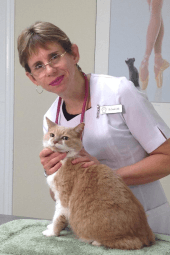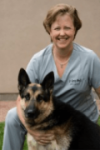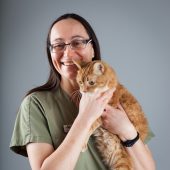We Asked - They Answered!
We asked the WSAVA/CVMA 2019 speakers to provide us with their lectures learning objectives, and the relevance for today’s practice. Below are their answers.
Dr. Melinda Merck
 Session/lecture title: One Health and Domestic Violence
Session/lecture title: One Health and Domestic ViolenceImportance of topic: Domestic violence will impact 1 in 3 women worldwide according to the World Health Organization. This means it directly impacts the veterinary practice through their employees, clients and patients. The pets in domestic violence homes have an 88% chance of being threatened, injured or killed. The pets and their owners are at high risk for injury and often bring their pets to the veterinarian. Domestic violence directly impacts our wellness in the veterinary community. Understanding domestic violence, the signs and resources, is critical for every veterinary practice.
Dr. Allen Schoen

Learning Objectives: The objective is to educate veterinarians on practical additional integrative approaches for various internal medicine and musculoskeletal conditions to improve their treatment outcomes. This integrative approach may help improve the quality and lifespan of companion animals.
Session/lecture title: Scientific Basis and Clinical Applications of Veterinary Acupuncture: How Does it Really Work and for What Conditions?
Learning Objectives: Scientific Basis and Clinical Applications of Veterinary Acupuncture: How Does it Really Work and for What Conditions? Learning objectives: The objective is for veterinarians to have a scientific understanding of how acupuncture works and for what conditions it may be of benefit for.
Session/lecture title: Acupuncture and Integrative Medical Approaches for Neurologic Conditions
Learning Objectives: The learning objective is for veterinarians to have a greater understanding of how acupuncture and integrative approaches may enhance treatment outcomes for various neurologic conditions. Attendees will learn how acupuncture, nutritional supplements and other complementary approaches will increase their successful treatment of neurologic conditions.
Session/lecture title: Creating a 21st Century Integrative Veterinary Medicine Practice to Improve the Well Being of Your Staff, Patients, Clients, You and Your Family
Learning Objectives: The learning objectives of this lecture are to teach veterinarians how to implement mind/body medicine approaches based on the latest research in neuroscience and quantum physics to create a healthier, happier work environment and personal life. Practical techniques that you can incorporate into your practice immediately, will be discussed.
Dr. Soren Boysen

Learning Objectives: Recent evidence suggests the learning curve to sonographically diagnose pneumothorax and pleural effusion is steep, with only moderate sensitivity. The objectives of this lecture are to review current thoracic veterinary point of care ultrasound protocols, present reasons clinicians might fail to correctly diagnose pneumothorax and pleural effusion, and to present pearls that will maximize the attendee’s success at diagnosing these two conditions.
Why is your topic important today and for participants?
Dyspnea is common in small animal patients and can cause undue stress when the patient first presents, and the underlying cause is uncertain. Given more than 30-50 % of small animals presenting with dyspnea have pleural effusion, and pneumothorax is common in trauma patients, knowing how to find even small amounts of pleural effusion and/or air can be key to successfully diagnosing and treating these patients. Point of care thoracic ultrasound can diagnose these conditions within 5 minutes, track their progression, help guide further diagnostics and therapy, and most importantly, can be performed cage side while other diagnostics and stabilization efforts are continued, thus minimizing the stress of managing the dyspneic patient.
Jennie Tait AHT, RVT, VTS (Dermatology)

Learning Objectives: There are two main types of people in veterinary medicine. Those who love dermatology, and those that run from it! One of the main reasons for this, (and what is most frustrating about dermatology), is that a lot of dermatologic diseases look very similar. Can you tell the difference between a skin infection and an autoimmune disease? Is what you are looking at secondary or primary? This lecture will give you better insight into what to look for in your patient’s history and physical exam, to be able to come up with differentials. Combine that will some appropriate diagnostics and you are off to the races. Come learn some of the tricks of the trade, and up your derm game.
Session/lecture title: Dermatology: Strategies for success with your derm cases.
Learning Objectives: Dermatology cases make up a huge part of the caseload seen in private practice and can be very frustrating for everyone involved. Most of these cases are complex in nature and require long term management. That makes working through these cases in a 20-minute appointment, extremely challenging. Take advantage of my experience as a VTS (Dermatology) and learn some tried and true strategies to help you improve your success when dealing with dermatology patients.
Session/lecture title: Drugs and Derm – understanding the drugs we reach for and why
Learning Objectives: Most of our dermatology patients are in for lifelong management vs cure. Most of our protocols for derm patients are multi-modal and are tailored for each individual patient, which can be confusing and overwhelming for owners. That means keeping those clients coming to your practice for the lifetime of their companion, can be a real challenge. Client communication and education are paramount when dealing with your dermatology patients. This lecture is meant to give technicians a better understanding of the derm cases they see, and how they are managed, so they can better assist clients with their understanding. When owners have a clear understanding, we get excellent compliance and better case outcomes. When you are able to explain to your client the reasoning behind their pet’s treatment protocols, you are able to get them “on board” and increase not only owner compliance but owner loyalty to your practice.
Session/lecture title: Diagnostic Techniques for Dermatology – getting an accurate diagnosis the first time ‘round
Learning Objectives: This presentation is intended to be a “Dermatology Bootcamp” to prepare you for success in the workup of patients with skin disease. Diagnostic techniques for dermatology include many simple in-house diagnostics, and because the skin is a uniquely simple organ to access, many samples can easily be collected during a patient’s examination. Cytology is simple to perform, inexpensive, and a very high-yield test that provides near-instant results. It should be performed in almost all cases. We will go through how to collect and interpret cytology results; review skin scrapings for the parasite you suspect, and how to improve your chances of success of finding them; review when and how to collect bacterial cultures, which are becoming increasingly important with the rising prevalence of resistant staphylococci; brush up on your techniques for collecting skin biopsies, fungal cultures, and trichograms, as well go over the basics of allergy testing in atopic patients. Mastering these skills is easy and will improve how you work up your dermatology patients.
Dr. Helene Perras

Learning objective: Wondering how to benefit from influencers and video? Learn how to attract new followers and open new channels of communication with pet owners.
Why is your topic important today and for participants?
Young pet owners are no different from others of their generation. They love social media, consult Dr. Google and follow influencers. Be where they are.
Dr. Stacee Santi
Learning objective: From building brand loyalty to raising your game with Millennials, attendees will have a new way to think about delivering a personalized experience to the modern day client using technology and “Use It Monday” strategies to grow the practice revenue and still get home for dinner on time!
Why is your topic important today and for participants?
Over 75% of Americans have a smartphone and spend an average of 4 hours per day staring at it. For practices to build sustainable and thriving businesses, reaching pet owners on their device is imperative. And, if done correctly, we can use it to strengthen the human-animal bond and keep the veterinarian in the center of pet healthcare. Move over Dr. Google- the Vet is in!
Dr. Beatriz Monteiro

Learning objective: Recent advances on the use of adjunctive drugs for management of acute pain will be discussed: What are they? How do they work? And most of all… Do they really work?
Why is your topic important today and for participants?
Appropriate management of acute pain is essential for providing state-of-the-art patient care. However, it has to rely on solid evidence-based medicine. Understanding these drugs and how to use them can have a great impact on animal health and welfare.
Session/lecture title: The secrets of dental pain: current knowledge (shared lecture with Paulo Steagall)
Learning objective: Recent studies have identified common behaviors of dental pain and a great need for analgesic management. This lecture will use evidence-based data, photos and videos to show you that!
Why is your topic important today and for participants?
Dental disease is one of the most common reasons for a visit to the veterinarian. Nevertheless, the literature on dental pain in pets was nearly nonexistent until recently. Knowledge on dental pain will ultimately impact how you manage these patients to provide them with better hospital experiences and better outcomes.
Session/lecture title: Treat postoperative pain using intraperitoneal and incisional anesthesia
Learning objective: Intraperitoneal and incisional anesthesia use non-controlled drugs, are low cost and quite effective for management of postoperative pain. Come learn how to safely and effectively use these techniques.
Why is your topic important today and for participants?
The opioid crisis has left us wondering what to do without them. Alternatives to opioid usage include the practice of multimodal analgesia which should always include local anesthetic techniques when possible. Intraperitoneal and incisional anesthesia are technically easy to perform, low cost and effective. Veterinarians can easily incorporate the use of these techniques into their routine practice.
Dr. Jyothi V. Robertson

Learning objective: This hands-on workshop will leave participants with the following tools:
- Morning and Evening Routines / Checklists — participants will learn about habit formation and the value of habit stacking for increasing efficiency and mental bandwidth.
- Guidance to design a personal mission statement to align with vision and goals – participants will work on their own mission statement to align their work and personal lives.
Why is your topic important today and for participants?
People in the animal welfare profession discuss concepts of capacity for care, as it relates to animal shelters and their organizations. It is as important, if not more, in individual lives. Operating beyond our own capacity leads to overwhelm and burn-out. Drawing parallels from the sheltering world, this lecture will examine our own daily routines and goals, to steer participants to focusing more awareness internally on how we meet the challenges of daily life and offers tools to improve overall efficiency and flow.
Dr. Leslie Lyons

Learning objective: Attendees will be capable of deciding what patients would be candidates for precision medicine genetic studies. Attendees will understand how genetic testing is performed and what mistakes in testing are common that affect sensitivity and specificity.
Importance to practitioners:
Genetics is now a common part of diagnoses for humans with diseases and in deciphering their responses to treatments and therapeutics, especially cancers. The same type of precision medicine can be applied to companion animals, giving state-of-the-art health care to our pets.
Dr. Gary Landsberg

Learning objective: Treating cats with chewing problems, whether household items or self-trauma, starts with diagnosis: is it normal, excessive or abnormal and are there underlying medical contributing factors. This seminar will address treatment strategies including addressing medical factors and stressors, providing for the cat’s behavioral needs, behavioral modification and medication, if indicated.
Importance to practitioners:
excessive or inappropriate chewing requires a veterinary consultation to diagnose and determine what and how to treat.
Session/lecture title: The Science of Canine Cognitive Decline and Dysfunction: Prevalence, Diagnosis and Clinical
Learning objective: This seminar will describe the clinical signs, prevalence, risk factors and the metabolic and pathological changes associated with brain ageing in dogs and cats. A diagnosis of cognitive dysfunction syndrome (CDS) requires identifying signs and excluding medical conditions that might cause or contribute to the signs.
Importance to practitioners:
Participants will learn the importance of identifying signs of cognitive dysfunction and the level to which they go unreported in order to become more proactive in identifying signs, ruling out underlying medical problems and diagnosing CDS.
Session/lecture title: The Science of Canine Cognitive Decline and Dysfunction: Evidence-Based Treatment Options
Learning objective: This seminar will describe the management and treatment options for cognitive dysfunction to improve signs or slow the progression of cognitive dysfunction syndrome. Environmental enrichment, nutritional supplements, and functional foods and drug options will be reviewed.
Importance to practitioners:
Learn treatment options for canine cognitive dysfunction and the evidence for their use.
Session/lecture title: Fear Free is Better Medicine: Preventing and Alleviating Veterinary Fear
Learning objective: A fear-free approach can prevent, alleviate and effectively manage pet fear, anxiety, and stress at veterinary visits, from the procedures to the hospital environment and from home to hospital and home again. This seminar will also review the signs of fear, anxiety, stress and pain, their impact on physical and emotional health, and on the quality and level of veterinary care the pet
Importance to practitioners:
Making veterinary visits fear free addresses both the mental and physical health of pets and their owners and increases the level and qualify of veterinary care the pet receives.
Session/lecture title: Medicate fear of travel and veterinary visit
Learning objective: Addressing fear, anxiety and stress during travel and veterinary visits is essential for the emotional and physical well-being of the pet, as well as for the owner and veterinary personnel. This seminar will review the selection and use of natural and pharmaceutical medications for alleviating fear and anxiety during travel and veterinary visits and their evidence of efficacy.
Importance to practitioners:
What natural and pharmaceutical interventions can be used to reduce fear and anxiety during travel and veterinary visits, what is their evidence of effect, and when and how should they be used.
Session/lecture title: Urine, Urine Everywhere and Even More to Spare: Marking Cats
Learning objective: House soiling is one of the most common behavior concerns reported by cat owners. Learn why cats soil outside the litterbox, diagnosis and differentials for urine marking, and how to treat marking by managing the environment, modifying behavior and with medication.
Importance to practitioners:
Recognizing the causes of soiling, and effectively diagnosing through behavioral history and medical workup, is essential to implementing an appropriate and effective treatment program.
Session/lecture title: M is for Medication: Pharmacotherapy for Canine Fear and Aggression
Learning objective: Together with environmental management and behavior modification, the use of behavior-modifying drugs and natural therapeutic, either on an as needed or ongoing basis (or both) might be indicated or necessary for a comprehensive treatment program. Drugs might be used to alleviate or lessen fear, anxiety, arousal, reactivity, hyperactivity, and impulsivity; for behavioral pathology (abnormal behavior); to aid in the acquisition of new coping behaviors; and to address the dog’s physical and emotional well-being.
Importance to practitioners:
Knowledge and understanding of behavioral medications are required for effective management, selection and use of drugs to treat behavior problems in which medication might a be useful or necessary for the pet and problem.
Kathy Istace, RVT, VTS (Dentistry)

Learning objective: This lecture will discuss how and why periodontal disease develops, contributing factors to periodontal disease, and the consequences of untreated disease. Attendees will learn how to recognize the various stages of periodontal disease and the treatment options available for each stage.
Importance to practitioners:
Periodontal disease is the most common infectious disease in pets. Being able to accurately recognize it, its effects, and knowing how to treat it will greatly improve patient care.
Session/lecture title: “The Complete Oral Health Assessment and Treatment (Dental COHAT)”
Learning objective: This lecture will cover the steps of a complete oral health assessment and treatment including oral examination, dental charting, and dental cleaning. It will also discuss closed root planing and perioceutic application.
Importance to practitioners:
Periodontal disease is the most common infectious disease in pets. Being able to properly treat it will improve patient care and client satisfaction.
Session/lecture title: “The Science Behind Dental Homecare Products”
Learning objective: This lecture will allow attendees to understand the various mechanisms of action behind the myriad of dental homecare products available today. Attendees will be better able to choose which products their hospital may wish to offer, as well as which to avoid.
Importance to practitioners:
Choosing which dental homecare products to recommend to your clients and assessing what will work best for each individual patient can be a daunting task when there are so many products available in the marketplace. Knowing how the various products work (and which ones don’t work) can make this a lot easier.
Session/lecture title: “Increasing Client Dental Compliance”
Learning objective: This lecture will help attendees gain better client compliance for dental procedures by addressing clients’ fears about general anesthesia, how to discuss costs, the importance of dental care. How to explain why anesthesia-free dental cleanings are not recommended will also be discussed.
Importance to practitioners:
Pet owners are often reluctant to make an appointment to have their pet’s teeth cleaned. To increase compliance, we must find out why, and be prepared to educate our clients and address their concerns.
Dr. Clara Goh

Learning objective: This session uses video footage to highlight practical take-home tips on efficient and accurate execution of FHO surgery. Both traditional craniolateral and novel ventral approaches will be covered, as well as how to optimize a successful outcome for every patient
Importance to practitioners:
FHO continues to be the most widely performed surgery in the management of hip dysplasia and traumatic hip injury. I am excited to share my expertise on how to make the surgery more fun and successful for your patients!
Dr. Sarah K. Abood
Learning objectives: Veterinary health care team members will learn how to evaluate a homemade diet for macronutrient (energy, protein, fat) content and determine if it is balanced. They will also learn about resources available for balanced recipes and how to develop a monitoring program for patients being fed homemade diets long-term.
Importance to practitioners:
The family veterinarian (and their health care teams) are on the ‘front line’ when it comes to identifying medical problems linked to an animal’s diet or feeding management. With the rise in popularity of homemade diets, veterinary health care teams must improve their monitoring programs to help prevent nutritional deficiencies or toxicities.
Dr. Doreen Houston
Learning objective:
- Objective 1: Understand the current state of knowledge regarding the significant risk factors for recurring struvite and calcium oxalate uroliths in dogs and cats
- Objective 2: Understand what has changed with management of the most common uroliths given our knowledge of minimally invasive procedures, antimicrobial resistance, the altered enteric microbial flora of stone formers, and the oxalate and hydroxyproline content of treats for dogs and cats, including human food.
Importance to practitioners: Uroliths in dogs and cats are not uncommon and calcium oxalate uroliths have a high rate of recurrence. Understanding risk factors and changing therapeutic guidelines will help us make the best recommendations for the management of these cases.
Dr. Lisa Weeth & Dr. Gregg Takashima
Learning objective:
- To understand and apply the basics of a routine nutritional assessment on all patients.
- To demonstrate how a simple and non-time-consuming diet review can enable you to identify potential nutrition problems and add to your successful diagnostic and treatment plans.
Importance to practitioners:
Many pet owners consider feeding their dog or cat an emotional bonding activity rather than simply a means of delivering calories and nutrients. Optimizing pet health through nutrition doesn’t need to be complicated, but with more companies making “best diet” claims and pushing new fads based on growing their market share rather than nutrition science it can be challenging to know what is truly the best diet approach for any given dog or cat.
Dr. Stephen Cital

Learning objective: Participants will learn the intrececies of product selection and dosing. We will discuss what evidence we have in small animals and research underway.
Importance to practitioners:
Participants will learn the intrececies of product selection and dosing. We will discuss what evidence we have in small animals and research underway.
Dr. Alexa Bersenas

Learning objectives: This lecture will focus on quickly differentiating respiratory presentations for quick decision making and management of the feline patient.
Importance to practitioners:
Cats frequently present to veterinarians with signs of respiratory distress. The therapeutic approach can be challenging and intimidating. This lecture will address often encountered decision-making scenarios and best practice approaches.
Session/lecture title: New options for oxygen therapy and respiratory distress
Learning objectives: The goal of this lecture is to review traditional oxygen supplementation modalities, and to introduce the small animal veterinarian to new oxygen modalities including current recommendations to their application.
Importance to practitioners:
Patients with severe respiratory distress unresponsive to traditional oxygen supplementation methods are faced with intubation and manual/mechanical ventilation or euthanasia. An intermediate respiratory modality that provides augmented oxygen supplementation is a new alternative for our veterinary patients.
Session/lecture title: Traumatic brain injury
Learning objectives: The goals of this lecture are to focus on the very important basic, as well as more advanced, therapeutic management strategies for the patient with traumatic brain injury.
Importance to practitioners:
Traumatic brain injury is a severe clinical presentation, however many head trauma patients can have an excellent prognosis. Appropriate management of these patients is key.
Session/lecture title: Emergency Approach to DKA
Learning objectives: This lecture will focus on emergency stabilization of the metabolically deranged DKA patient, and ongoing management through to resolution of ketonemia
Importance to practitioners:
The needs of the DKA patient are frequently changing from admission to stabilization. Anticipating the requirements of the DKA patient is key to optimizing clinical resolution.
Dr. Noel Clancey
Learning objective: To provide various techniques and methods of fine-needle biopsies, slide preparation and submission details that may assist in fewer non-diagnostic results.
Importance to practitioners:
Cytology is a rapid, minimally invasive, relatively inexpensive, powerful clinical tool, yet may yield non-diagnostic results for a variety of reasons, including type of tissue sampled, poor sampling/preparation techniques and submission detail errors. This session will review several sampling and preparation techniques as well as provide tips/pointers in effort to improve the number of diagnostic samples.
Session/lecture title: Basic Cytology
Learning objective: The primary goal of cytology is to obtain information about a lesion, which in many cases may be definitive, but in others may only provide partial information. This session is designed to provide basic foundations that assist one in making sound cytological interpretations.
Importance to practitioners:
Cytology is a minimally invasive, relatively inexpensive, powerful clinical tool that can be employed in-clinic allowing for rapid and sometimes critical information. However, the experience is necessary to make sound conclusions and to avoid over- or under-interpretation of select details. This session will provide a basic cytological algorithm and examples of several straight forward lesions that can be easily diagnosed with solid basic training.
Session/lecture title: Evaluation of Effusions
Learning objective: To review the basic sources of cavitary effusions and to review cytological and other features that help classify basic and specific effusions.
Importance to practitioners:
The physical appearance, total nucleated cell count, protein concentration and microscopic features of a fluid are used to evaluate potential sources of cavitary effusions. This session will review how basic and specific effusions are classified and how the above components contribute to classifying effusions, as well as aid in determining potential underlying causes to cavitary effusions.
Session/lecture title: Lymph Node Cytology
Learning objective: To provide an overview of lymph node cytology, including normal and hyperplastic/reactive lymph node features, lymphadenitis, lymphoma and metastatic disease.
Importance to practitioners:
Patients with enlarged lymph nodes are routinely encountered in small animal practice. Cytological evaluation of lymph nodes can be rapidly performed providing critical information, ultimately decreasing delays in initiating specific therapies when warranted.
Dr. Fe ter Woort
Learning objectives: be able to quickly collect accurate information with your ultrasound, and how to use this information to make treatment decisions for colic cases.
Importance to practitioners:
The FLASH exam is relatively straightforward and easy to learn and as such readily applicable in equine practice. It does require image recognition of the classic abnormalities, and this session provides an opportunity to review these classic and less classic abnormal images.
Session/lecture title: Detailed Abdominal Ultrasound in the Horse: When it Pays to take Your Time
Learning objective: knowing in which specific cases it’s worth taking the time for a complete abdominal ultrasound and what to hunt for in those cases.
Importance to practitioners:
The normal abdominal ultrasound exam can sometimes appear as a sea of grey but paying attention to the small details provides crucial information in some cases. This lecture will cover the abnormal details to pay attention to which make a difference in case management.
Session/lecture title: Cardiac Evaluations in the Pre-purchase Exam: How the Echocardiogram Helps Assess Prognosis
Learning objective: provide valuable information to your client based on accurate cardiac auscultation and understand the common an uncommon findings on the echocardiogram and what they mean for the horse’s athletic prognosis.
Session/lecture title: Laryngeal Ultrasound in Practice: When does this Tool Make a Difference in Case Management
Learning objective: being able to recognise the normal and abnormal structures of the equine larynx and understanding what the abnormal images mean in the context of case management.
Importance to practitioners:
Laryngeal ultrasound can be done with the linear ultrasound probe used for tendons and as such is technically accessible to many practitioners. However, the laryngeal anatomy is complex and identifying normal structures on the ultrasound exam is not straight forward at first. In specific cases, the ultrasound exam does provide crucial information that changes the treatment plan or surgical approach.
Session/lecture title: Overground Endoscopy: Spectacular and Subtle Case Discussions
Learning objective: identify subtle abnormalities and see some more spectacular videos not encountered in practice every day.
Importance to practitioners:
Overground endoscopy is being used more and more. Not only in horses with obvious respiratory noise, but also in pre-purchase exams in which case the findings are often subtle and interpretation can be tricky.
Dr. Susan Little
 Session/lecture title: Brachycephaly and Other Breed-Associated Problems in Cats
Session/lecture title: Brachycephaly and Other Breed-Associated Problems in CatsLearning objective: Awareness is increasing about the deleterious effects of extreme phenotypes in many animals – this presentation will focus on the health aspects of common breed-associated phenotypes in cats.
Session/lecture title: Diagnosis & Management of Feline Hypertension
Learning objective: This presentation will discuss evidence-based recommendations for safe and effective methods to relieve urethral obstruction in cats. This lecture will focus on best practices for diagnosing hypertension in cats and will discuss available treatments and monitoring.
Session/lecture title: Approach to Elevated Liver Enzymes in Cats
Learning objective: Elevated liver enzymes are common in cats – this presentation will discuss a practical and logical approach based on an algorithm to determine the underlying cause.
Session/lecture title: Update on FeLV and FIV Testing: it’s a New World
Learning objective: Retrovirus testing guidelines are changing – this presentation will discuss current challenges in diagnosis of FeLV and FIV.
Session/lecture title: Top Tips for Anorexic Cats
Learning objective: Decreased appetite is common in cats – this presentation will discuss when to intervene, and the most effective strategies.
Dr. Terry Jackson
Learning Objectives: Learn about existing and potential client’s perceived veterinary care delivery demands through effective market communication and in practice techniques resulting in increased client number growth, client compliance and increased transaction fees. Learn how to set your practice apart from the competition, increase client compliance, all the while increasing your financial return and enjoying the benefits of positive reacting clients.
Session/lecture title: Employee Incentive program
Learning Objectives: Learn how to decrease HR headaches and management leading to increased practice revenues and control/decrease direct operating costs through employee incentive programs formulated on practice operating objectives.
Why is your topic important today and for participants?
The seminar topic is relevant in today’s veterinary competitive market resulting in professional fee pressure and increasing staff resource turnover and employee HR challenges.
Dr. Douglas Mader

Learning Objectives: Understanding the unique anatomy of the common reptile patients will assist the clinician in their physical exams, radiographic interpretation and surgical precision. This a must-attend session for any practitioners working with these amazing animals!
Session/lecture title: Why won’t my reptile eat?
Learning Objectives: Hyporexia and anorexia are the most common problems seen in captive reptiles. These are not diseases, they are symptoms. Understanding the “normal” physiology of these species will help the clinician diagnose common problems that lead to a loss of appetite.
Session/lecture title: Common Infectious Diseases in Reptiles
Learning Objectives: Reptiles are susceptible to diseases much different from those seen in dogs and cats. Knowing what to look for will help the reptile practitioner diagnose the problems and help direct necessary therapeutics.
Session/lecture title: Antimicrobial Therapy in Reptiles
Learning Objectives: A critical follow up to lecture #3, knowing what drugs are best to use, and HOW to use them in reptile patients will greatly enhance the practitioner’s ability to treat these unique patients.
Dr. Séverine Tasker

Learning objective: FIP is one of the most important causes of death in young cats. This lecture will enable you to understand which tests are able to confirm a diagnosis of FIP and how to differentiate these from those that can help you support a diagnosis of FIP. Evidence published in recent studies discussing the use of PCR (including spike gene mutation analysis) for diagnosis will be discussed with take-home message prominent throughout the lecture.
Why is your topic important today and for participants?
FIP is seen relatively frequently in practice yet we still struggle with definitive diagnosis, partly because the pathogenesis of the disease is probably a complex interaction of host and viral factors.
Dr. Charlie Pye
Learning objective: Skin cytology is a quick and simple tool that can provide much-needed information about secondary infections when a patient presents with dermatologic disease. In this presentation, we will review cytology technique and how to interpret cytological samples under the microscope.
Why is your topic important today and for participants?
Performing cytology is a great way to identify infections on the skin. However, interpreting cytology can be challenging so feeling confident reading cytology is important in practice.
Session/lecture title: The Art of Skin biopsy
Learning objective: A skin biopsy is a powerful tool in veterinary dermatology and can help us reach our definitive diagnosis. During this presentation we will review biopsy site selection, technique and how to avoid errors in obtaining skin biopsies.
Why is your topic important today and for participants?
Obtaining a good sample via biopsy is paramount to allow histopathologists to describe the skin lesions and provide us with a diagnosis.
Session/lecture title: Common Immune-mediated dermatologic diseases
Learning objective: Immune-mediated skin disease generally requires lifelong treatment using immunosuppressive medications. In this lecture, we will review some of the more common immune-mediated skin diseases in companion animals discussing the clinical presentation, diagnosis and treatment options.
Why is your topic important today and for participants?
As immune-mediated dermatologic conditions can require aggressive immunosuppressive treatment, it is important to be able to accurately diagnose these diseases and know all treatment options available should the first selected treatment fail to improve the patient’s clinical signs.
Session/lecture title: Common reasons for treatment failure
Learning objective: Frustration can arise when treatment instituted for a particular dermatologic disease fails to lead to clinical improvement. During this lecture we will review the most common reasons for treatment failure along with diagnostic/therapeutic steps to take, should your treatment fail.
Why is your topic important today and for participants?
Knowing how to troubleshoot when treatment isn’t “going according to plan” will help decrease frustration for the client and yourself and hopefully provide a more definitive diagnosis in these cases.
Session/lecture title: They’re not itchy what do I do now?
Learning objective: When a patient is not pruritic, it can be difficult to determine the underlying etiology as there is a long list of differential diagnoses. Many diseases look strikingly similar and can only be differentiated based on ruling out other disease processes, so in this lecture we will review diagnostic steps for the non-pruritic patient with skin disease.
Why is your topic important today and for participants?
Having a differential diagnosis list to guide your steps through the diagnostic process is of upmost importance when dealing with a non-pruritic patient so that more invasive tests are not performed unnecessarily.
Dr. Meghan Herron

Learning objective: Understand how to read and correctly interpret the body language and intent of canine and feline patients. Learn to alter your own body language to convey a message that is non-threatening and more conducive to safe and effective handling
Why is your topic important today and for participants?
Human injury from bite and scratch wounds is a serious issue for veterinary personnel. Learning how to predict behavior and prevent bites from happening is essential in keeping people safe and patients happy.
Dr. Julius Tepper

Learning objective: High-quality water is essential for fish health. Pathogen control in natural aqua-systems occurs by physical, chemical and biological means.
Why is your topic important today and for participants?
These control mechanisms need to be present in artificial aqua-systems if the disease is to be prevented. Are they found in yours?
Dr. Franck Ollivier

Learning objective: To review the causes, clinical signs, diagnosis and treatments of the main ocular diseases occurring in aged dogs and cats.
Why is your topic important today and for participants?
Because of the progress of veterinary medicine, cats and dogs live longer. It is therefore important to be able to identify and treat the ocular diseases of aging dogs and cats.
Session/lecture title: Ocular emergencies
Learning objective: Learn the aetiology, clinic signs, diagnosis and treatments of the main ocular emergencies occurring in dogs and cats.
Why is your topic important today and for participants?
Ocular emergencies are quite frequent in dogs and cats and it is therefore important to acquire good knowledge that should almost become likes reflexes in order to treat them adequately and in a timely manner.
Session/lecture title: Ocular diseases in cats
Learning objective: To review the causes, clinic signs, diagnosis and treatment of the main ocular diseases specific to cats
Why is your topic important today and for participants?
Because the population of cats does not stop increasing, it is therefore important to be able to identify and treat the ocular diseases specific to them
Session/lecture title: Ophthalmology quiz (presentation of common and unusual ophthalmic cases)
Learning objective: Come and test, in an interactive and funny way, your knowledge in ophthalmology through a bunch of real clinical cases that will be very common ones, and unusual ones as well!
Why is your topic important today and for participants?
Almost “hands-on” in various cases. In a ludic way, you will be asked to answer questions about causes, differentials, treatment options, etc.
Dr. Bonnie Wright

Session/lecture title: Acupuncture for acute pain.
Learning objectives: understand the electrical and chemical changes that occur through mechanotransduction using acupuncture peri-operatively. Learn how to combine these effects with the chemical and electrical changes induced by pharmacological compounds.
Session/lecture title: Opioid free peri-operative analgesia (with Peter Kronen)
Learning objectives: Learn how to combine pharmacological and non-pharmacological tools for providing adequate peri-operative analgesia without requiring the use of opioids. Understand the neuro-inflammatory effects of opioids, and why analgesia may be superior without them when properly performed.
Session/lecture title: How I treat GI dysmotility in the ICU
Learning objectives: Combining pharma and non-pharma to treat a common and frustrating condition that occurs both from common diseases, as well as common medications used to treat these diseases.
Dr. Åke Hedhammar
Learning objective: Most inherited diseases are complexly inherited and affected also by environmental factors. To research and manage them we need understanding and collaborations between practicing veterinarians and scientists.
Importance to practitioners: After a shift in our caseload from infectious and nutritional diseases to developmental and degenerative disorders we are now faced with mostly complex inheritance that calls for breeding advice as well as environmental changes. Breeding advices as well as interventions for this kind of diseases are tricky and yet not fully appreciated. Let’s collaborate on how to manage them.
Dr. Brook A. Niemiec

Dental disease is the most common problem in small animal dentistry. Using numerous high-quality images, we will present the pathophysiology and ramifications as well as diagnostic and treatment options. Topics will include: fractured teeth, tooth resorption, abscessed teeth, retained deciduous teeth, malocclusions, neoplasia, immune-mediated disease, and caudal stomatitis.
Periodontal Disease: Pathogenisis and Local and Systemic ramifications
Periodontal disease is the most common problem in small animal patients. Not only is it common, but there are also numerous local and systemic effects of the infection. Sadly, most of what we “know” about this disease is wrong. This presentation reviews the true pathophysiology and importance of periodontal disease to clients, patients, and your practice.
Periodontal therapy for the general practitioner
This lecture will cover proper diagnosis and therapeutic options for periodontal disease. Subject matter to include: performing a thorough professional dental cleaning, recognition of dental pathology, treatment of pathologic pockets, as well as homecare. Finally, this lecture will introduce more advanced periodontal therapies.
Dental radiology techniques and basic interpretation
Dental radiographs needn’t be a daunting or difficult task. We will teach you a very easy system to get the shot right the first time. This lecture will begin with a discussion of radiation safety and equipment options, including Finally, we will cover basic interpretation skill for the common diseases including: periodontal disease, trauma, neoplasia, infected/abscessed/dead teeth, and deciduous dentition.
Surgical Extractions/complications
The majority of this lecture will cover the techniques necessary for optimal success, minimal operator stress, and atraumatic extraction of teeth. This lecture initiates with a discussion of proper sectioning of multi-rooted premolar and molar teeth. Building upon this, we will discuss surgical extractions for difficult teeth (canines, carnassials, and ankylosed). Proper flap creation for the various teeth, alveolar bone removal, sectioning (if necessary), and closure (emphasizing tension release) will be covered. Finally, avoidance and treatment of various complications (fractured and retained root tips, oronasal fistulas, iatrogenic fractures) will be discussed. There is something for everyone in this lecture, from new grads to seasoned practitioners
Increasing Dental Compliance
Get the most out of your dental service and promote optimal patient care. This lecture will sum up the information from the entire dental track and let you “use it on Monday”. This is an in-depth lecture on how to increase compliance with your dental recommendations.
Dental therapy, the next level
Veterinary dentistry is much more than cleanings and extractions. This lecture will cover the two undertreated areas in veterinary dentistry, periodontics and restorative dentistry. The periodontal section will cover closed and open root planing, various flap techniques, and bone regeneration (guided tissue regeneration). Restorative therapy will cover bonded sealants for uncomplicated crown fractures as well as composite restorations for enamel hypocalcification and caries.
Dr. Linda Jacobson & Dr. Jyothi V. Robertson


Learning objective: This lecture will describe the psychopathology and subtypes of animal hoarding and the growing importance of institutional hoarding. It will discuss new and more effective ways that veterinarians and communities can deal with animal hoarding behavior. We will provide an overview of medical and behavioral conditions that are common in hoarded animals, and present new data on the Pandora’s box of otitis media in cats with chronic URI.
Why is your topic important today and for participants?
Animal hoarding is a “malignant form of cruelty”. It subjects large numbers of animals to illness, neglect and emotional distress over long periods of time. It is important for veterinarians to be aware of new psychiatric developments in the field of hoarding so as to be able to appropriately identify and work with people who hoard animals. Knowledge of the medical and behavioral problems commonly found in hoarded animals allows practitioners to identify hoarding behavior in clients and to appropriately manage the fragile patients that have lived in hoarding environments.
Session/lecture title: Dealing with animal hoarding in different geographic and socio-economic settings
Learning objective: The harm reduction approach has been increasingly applied to animal hoarding, in order to improve outcomes and reduce recidivism rates. This talk describes examples of animal hoarding situations in the USA, Brazil and two regions of Canada, and how different approaches were applied in different settings.
Why is your topic important today and for participants?
Historically, animal hoarding was managed by waiting until the situation was desperate, then moving in and seizing all the animals. This was traumatic to the people involved and often resulted in large numbers of euthanasias. Recurrence rates approached 100%. More recently, a more collaborative and gradual approach has helped clients to improve the standard of care for fewer animals, while allowing animal welfare agencies to provide care and humane outcomes for the rest. Maintaining respectful and constructive contact after an initial intervention provides a higher likelihood of long-term success. This talk highlights the rewards and difficulties of the harm reduction approach in different settings.
Dr. Teresa Bradley Bays

Learning objective: Advice on what to do and what not to do when working up small mammal cases are presented in order to guide practitioners to make the best decisions for their small mammal patients and to boost confidence in providing the best care.
Importance to practitioners:
This is important for general practitioners who see small mammals to have an idea of common issues that I see in our referral practice for exotics. It is also good for stimulating thought on how things can be done differently to make practice with exotic pets more efficient and effective.
Session/lecture title: Exotic Animal Practice Tips
Learning objective: Every practice does things just a little differently. These practice tips, specific to exotic animal practice, are presented in order to show how little changes can make diagnosis and treatment of exotic pets easier, less stressful and safer for our patients.
Importance to practitioners:
This is important for stimulating thought and reevaluating how we approach practice with birds, reptiles and small mammal patients. Little changes can make big differences in our success and in decreasing stress for our exotic patients.
Session/lecture title: Common Toxins in Companion Birds
Learning objective: The most common toxins that companion birds can be exposed to are described including sources, clinical signs and recommended treatment.
Importance to practitioners:
This subject is important because toxin ingestion and exposure in pet birds are more common then most people realize and chronic low-grade illness can often be due to the effects of undiagnosed toxin exposure.
Dr. Cecilia Villaverde

Learning objective: I will present the main nutritional and dietary strategies in the management of canine and feline chronic kidney disease, focusing on the new diets that target early stages and discuss the evidence supporting their use
Importance to practitioners:
Chronic kidney disease is very common both in dogs and cats, especially the elderly, and dietary management is the cornerstone of treatment. Choosing the adequate diet depending on the stage of disease and the nutritional evaluation will result in the improvement of both the quality and quantity of life of these patients. Moreover, there are many diets in the market and it is important to learn how to choose the best option
Dr. Etienne Côté

Learning objective: Dogs and cats that have concurrent heart and kidney disorders are a quandary because treatments for one can be detrimental to the other. This session provides practical approaches to managing this situation both in the acute setting and the chronic setting.
Importance to practitioners:
This topic is important because giving an unfairly poor prognosis to a patient with concurrent cardiac and renal diseases can lead to premature euthanasia.
Dr. Joanna Murrell

Learning objective: The aim of this lecture is to discuss when to and when not to use NSAIDs in the peri-operative period.
It will look at the evidence base for NSAID use in dogs and cats and discuss common conundrums like use in renal and GI disease
Importance to practitioners:
NSAIDs are valuable drugs that provide good pain relief. However, misuse in the peri-operative period can have catastrophic or even fatal consequences for cats and dogs, therefore knowing when to use them safely is imperative
Session/lecture title: Management of Acute Pain: Over-use of opioids perioperatively: what’s the problem?
Learning objective: The aim of this lecture is to provide a practical and evidence-based review of the side effects of opioids in dogs and cats, highlighting why overuse of opioids is problematic
Importance to practitioners:
Opioids form the backbone of peri-operative analgesic regimens and have a central place in peri-operative pain management. However, they also have side effects that can be disadvantageous for rapid patient recovery and well being. Understanding these side effects is the first step to reduce opioid use in general practice.
Dr. Marilyn Dunn
Learning objective: This new field allows minimally invasive treatment options for a variety of conditions. Correct ectopic ureters and remove stones without surgery!
Session title:
Lower Urinary Tract Tips : Part 1
Lower Urinary Tract Tips : Part 2
Learning objective: Practical urinary tricks you can do in your clinic. You will be able to catheterize every female dog and cat, perform urohydropulsion and unblock any blocked cat following these sessions!
Session title: Laser Surgery of the Urinary Tract: The Future is Now
Learning objective: Lasers are the new scalpels! No bleeding, quick healing, less pain and no fibrosis. Come see how lasers are changing the treatment of ectopic ureters, stones, tumors and much much more.
Session title: Laser Turbinectomy: Helping Bracycephalics Breathe Better 
Learning objective: The nasal cavity has long been ignored in these breeds. Turbinectomy is revolutionizing the treatment of obstructive brachycephalic syndrome.
Session title: Stones Stones go away..come again another day…Not
Learning objective: Latest updates on treatment and stone prevention. A lecture not to be missed as it will ROCK!
Session title: Tracheal Collapse: To Stent or not to Stent?
Learning objective: After 15 years of tracheal stenting, we have learned lots! Come hear the latest updates on patient management and stenting options.
Dr. Philipp Mayhew
Learning objective:
- Understand the principles of good suture and suture pattern choices for use in different body systems
- Gain knowledge of the latest products and trends in the field including antibacterial sutures, barbed suture and stapling technology for use in practice
Objectives: The field of surgical closure devices including suture and stapled closure devices is constantly changing. Basic principles will be reviewed in this session, but new developments and technologies will also be presented to keep the practitioners up to date on this important and fast-changing field.
Session/lecture title: Local skin flaps that any practitioner can use
Learning objective:
- Understand anatomic considerations and principles of use for different local skin flaps.
- Gain confidence in the use of local flaps including axillary and inguinal fold, advancement, transposition and rotational flaps.
Objectives: This lecture will focus on the use of local flaps and skin tension relieving techniques to give practitioners more tools to deal with challenging wound closure situations and oncologic resections.
Session/lecture title: Thoracic surgery for the private practitioner: What you need to know
Learning objective:
- Understand the different surgical approaches to the thoracic cavity
- Understand equipment needs and principles of pulmonary resection, pericardectomy, biopsy of thoracic structures as well as chest wall trauma.
Objectives: While thoracic surgery may not be a commonly performed procedure by all practitioners in this lecture, we will discuss surgical approaches to the thorax and develop a sense for good case selection for both the budding thoracic surgeon as well as the more seasoned practitioner.
Session/lecture title: Gastrointestinal surgery: Challenging cases
Learning objective:
- Understand important principles of gastrointestinal surgery including best practices for enterotomy and resection and anastomosis
- Gain confidence in approaching the more challenging cases in canine and feline gastrointestinal surgery
Objectives: This lecture will provide tips and tricks for optimizing outcomes in general gastrointestinal surgery before discussing those more challenging situations in the gastrointestinal tract that practitioners are not faced with every day. Strategies for these more complex situations will be discussed using case examples both for small and large intestinal lesions.
Session/lecture title: Treat gastroesophageal reflux and hiatal hernia
Learning objective:
- Understand functional and dynamic anatomy and the diagnostic approach to hiatal herniation and gastro-esophageal reflux disease.
- Know the latest treatments and expected outcomes for medical and surgical management of this complex condition in dogs and cats.
Objectives: We will discuss diagnostic and therapeutic options for both hiatal hernia and excessive gastroesphageal reflux cases. The challenging decision-making process that surrounds both the medical and surgical management of suspected or confirmed hiatal herniation in dogs and cats will also be covered in this lecture including the latest surgical options.
Saye Clement, DVM & Senani Ratnayake, RVT
This track has been strategically designed for owners, managers and all members of the veterinary team. You will receive practical tools and versatile ideas that will improve your management skills, enhance your personal development and refine your communication with co-workers. Compensation of team members is the single largest expense in veterinary medicine, so it’s time to shed some light on how to best manage maximize your most important resource! Join us in this safe and collaborative environment to customize a plan that will enable you to hit the ground running when you return to your practice!
Personal Culture – It’s Not About Your Yoghurt! (Clement/Ratnayake)
Your two speakers work full time in veterinary hospitals – in the trenches. We will be giving you real life strategies for managing your personal culture, and the impact it has on 3 key areas: the financial success of your practice, client satisfaction and the emotional health of your team.
Learn to Communicate Naturally (Ratnayake)
Understand how the differences of individual team members can work for, and unite your team. Appreciate the communication preferences of those around you and learn how to make your verbal and non-verbal communication with both clients and team members effective and efficient.
Growth Mindset – How To Achieve More (Clement)
Ever had a problem where you couldn’t come up with a solution? An awareness of Growth and Fixed Mindsets in both you and your team will help you to formulate novel solutions to old problems! Learn how a change in mindset will open up new ways of thinking!
Your Invisible Clients – Your Team (Clement)
Imagine a world where you don’t have to worry about financial success, HR issues and apathy in your hospital. Learn how the simple act of giving your co-workers a voice, will unite and energize your team.
When “It’s Not a Problem” is the Problem (Ratnayake)
Overcome the frustration that comes with being the only one on your team that recognizes a problem! Here’s your step-by-step guide for effectively raising the red flag; communicating issues in a compelling way, and raising engagement levels around topics that matter.
Potato, Potahto, Don’t Call the Whole Thing Off (Clement)
Does talking to your Baby Boomer Boss frustrate you? Do you not see eye-to-eye with your
Millennial Customer Service Representative? This lecture is not for you if you want to bash other generations – instead, you will learn constructive and easily applied skills to help facilitate communication across the generation gap!
Rallying the Troops – Strategies for Success (Ratnayake)
Are you overwhelmed by the process of getting buy-in, overcoming resistance, encouraging collaboration or just plain getting engagement from those around you? Effective and simple tools for any member of the team to take back and achieve success.
Building Your Toolkit – Real Life Challenges (Ratnayake/Clement)
Applying the knowledge and tools covered throughout the day, work through your own real-life challenges in a safe and collaborative setting. Leave with a plan that will allow you to implement on Day 1!
Dr. Anthony Yu
Learning objective: Eliminate ectoparasites including Sarcoptes and Demodicosis – it is too easy not to. Combination allergies are common – when working up a patient, be certain to identify all contributing factors to bring patients below their allergic threshold including environment, food, insect, bacterial and yeast hypersensitivities. Allergy testing is used to identify allergens to avoid and include in immunotherapy NOT as a diagnostic tool.
Session/lecture title: Update on Treatment of Atopic Dermatitis
Learning objective: Set client expectations before embarking on therapy. Immunotherapy is still our safest and best long-term treatment option for environmental allergies. Multimodal therapy is the key to success when treating allergies. Itch is induced by inflammation, neurogenic and psychogenic factors. It often takes a combination of therapies to control all aspects of itch. In clinical cases with existing allergies, consider instituting preventative therapy one month prior to their typical allergy season to help minimize adverse reactions to medications and development of secondary infections.
Session/lecture title: Strategies to Prevent Allergic Dermatitis
Learning objective: Allergies have a high heritability rate and as such, judicious breeding practices are key to outcross this condition. Implementing hygiene hypothesis principals in the pets environment will help to return balance to the T-helper-1/T regulatory/T-helper-2 cell trilogy. Considering vaccination strategies to minimize over-stimulation in predisposed breeds will help to decrease further development of allergies. Early detection of predisposed patients may allow us to use strategies to promote immunotolerance and prevent development of allergies.
